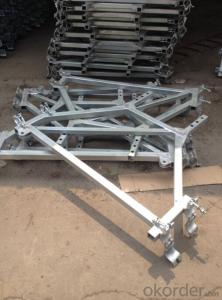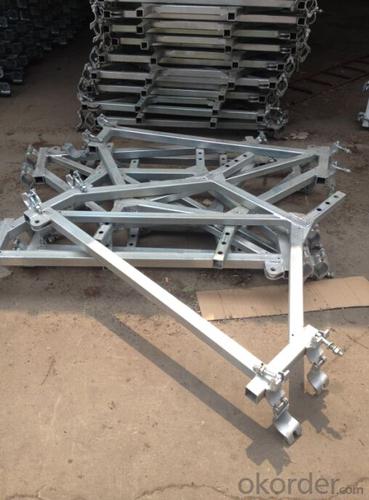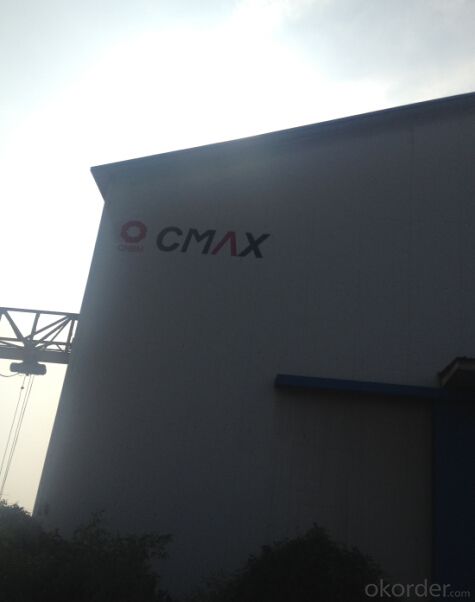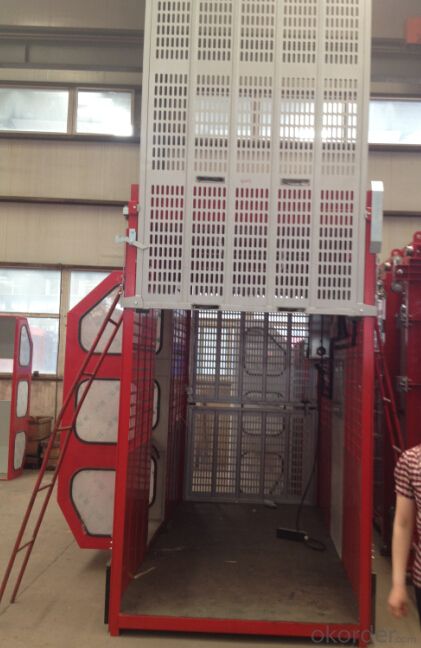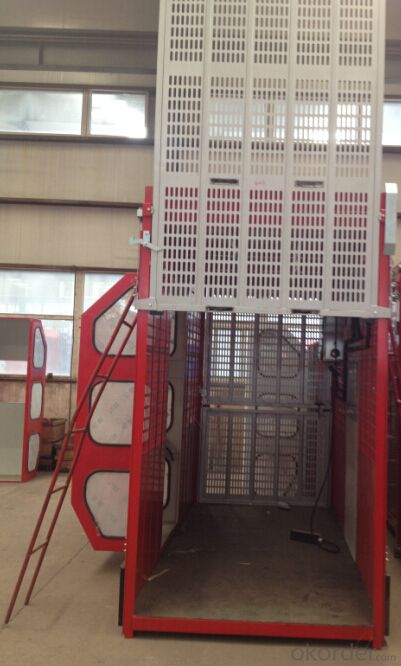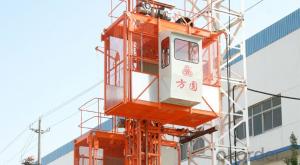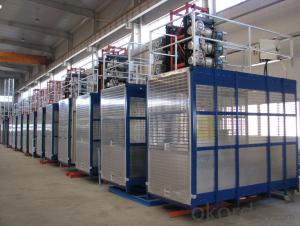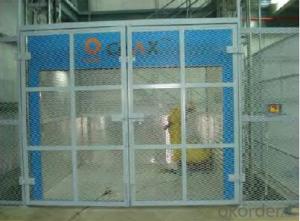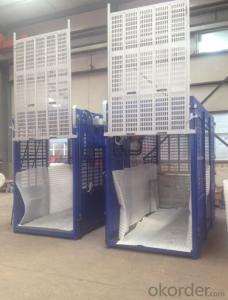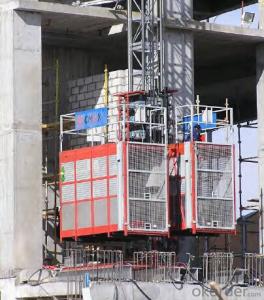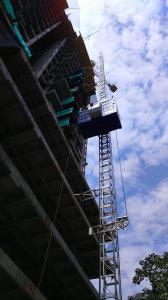SC Series Double Cage with 2 Ton Capacity Building Material Hoist
- Loading Port:
- China main port
- Payment Terms:
- TT OR LC
- Min Order Qty:
- 1 set
- Supply Capability:
- 1000 set/month
OKorder Service Pledge
OKorder Financial Service
You Might Also Like
Specification
SC200/200 3*2*11kw building electric hoist
Descriptions of our building hoist:
SC100 construction hoist is a new generation product designed by construction mechanization research, Chinese Academy of Architecture. It is of high technology and of high safety, convenient to maintain, is an ideal Vertical transport tool for modern building .
Main Features of Building Material Hoist
1. the recommended cage dimension(LXWXH):2.0X1.0X2.5, 2.5X1.0X2.5, 2.5X1.3X2.5, 3.0X1.5X2.5, 3.2X1.5X2.5, 3.8X1.5X2.5, 4.0X1.5X2.5, 4.2X1.5X2.5 etc, we can also manufacture cages of other size according to the user.
2. The cage and the door material can be aluminum molded board, punched-plate, figured aluminum board or other type according to your requirements.
3. The mast and the tie-in surface can adopt paint-spray, or hot galvanizeing processing.
Advantage of our building hoist:
1. Our own systems of production engineering.
2. Production design from the concept to the engineering details.
3. Technical experts with great experience in the sector.
4. Continuous development of new solutions and products adapted to the requirements of our clients.
5. Methodology and project procedure administration in compliance with current guidelines.
6. Extensive worldwide commercial network
Specification of our building hoist:
Characteristic | Model | Rated Loading | Lifting Speed | Motor Power |
Double cabin | SC200/200 | 2×2000kg | 33m/min | 2×(3×11kw) |
SC150/150 | 2×1500kg | 33m/min | 2×(2×15kw) | |
SC100/100 | 2×1000kg | 33m/min | 2×(2×11kw) | |
Single cabin | SC200 | 2000kg | 33m/min | 3×11kw |
SC150 | 1500kg | 33m/min | 2×15kw | |
SC100 | 1000kg | 33m/min | 2×11kw |
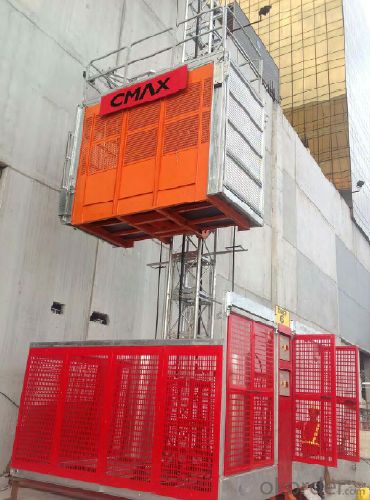
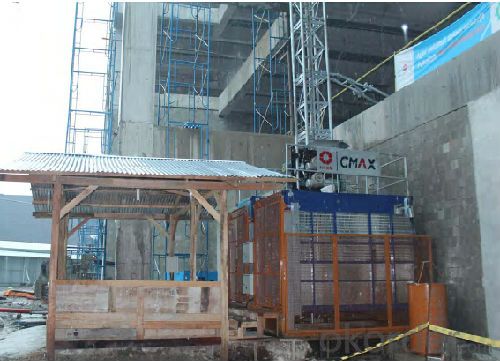

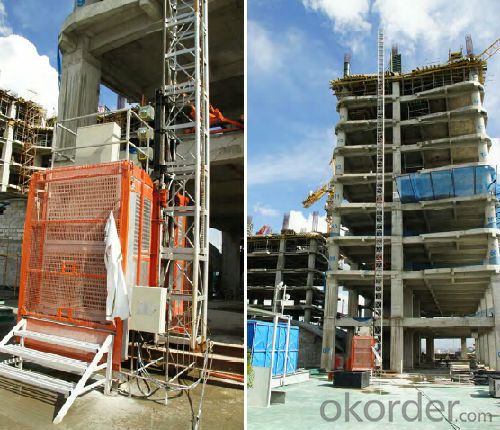
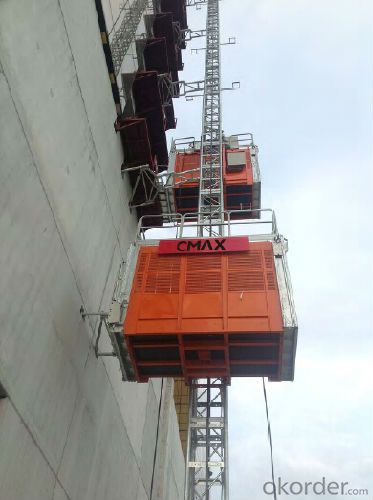
Production line
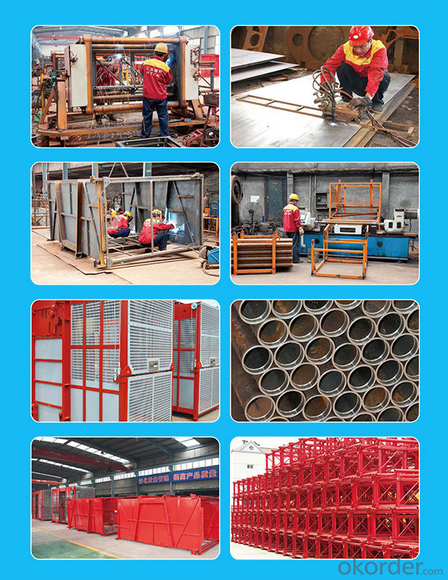
FAQ
1. why chose us?
China National Building Materials (Group) Corporation (CNBM), established in 1984,now is one of the largest state-owned group corporation in China, dealing with building materials & industrial equipment. Up to year 2010, CNBM Group's total asset is 20 billion USD and total staff is more than 100,000.CNBM International Corporation, specializes in designing & manufacturing of various
kinds of construction machinery, including tower crane, building hoist, etc. All the equipment produced by CNBM are compliant with the National level quality standard, and wins great reputation for their endurable performance in worldwide markets.
2.How about the shipment?
You can put 2 sets of of wheel loaders in one 40HQ container. The spare parts are packed with boxes.
The delivery time is 20 days.
3. What about your service?
We have our factory, we can meet customers needs as soon as possible.
We have first rate professional technology and provide good after-sales service.
4.After Sales Service
We offer the Preventative Maintenance and After Sales Service. For we strongly feels about the importance of supporting our customers and the product solutions we provide. Consequently we offer comprehensive maintenance options to prevent equipment issues before they become problems. Also we offer one year guarantee period.
- Q: This question asks for an explanation of how to use an overload protection device specifically in the context of a building hoist.
- <p>An overload protection device is crucial for a building hoist to prevent accidents caused by excessive weight. First, ensure the device is correctly installed and calibrated according to the manufacturer's instructions. Before operating the hoist, set the overload limit based on the hoist's capacity. During operation, if the load exceeds the set limit, the device should automatically shut down the hoist, preventing further operation. Regularly inspect and test the device to ensure it functions properly. Always follow safety protocols and never attempt to bypass or disable the overload protection system.</p>
- Q: This question asks for safety guidelines and procedures to be followed when operating a building hoist.
- <p>To use a building hoist safely, follow these guidelines: Ensure the hoist is regularly inspected and maintained by qualified personnel. Never exceed the hoist's load capacity. Keep the hoist and its surroundings clean and free from debris. Always use safety hooks and never leave the hoist unattended when in use. Ensure all safety features, such as limit switches and emergency stop buttons, are functioning correctly. Train operators on the proper use of the hoist and adhere to all manufacturer's instructions. Never use a hoist if it shows signs of damage or malfunction. Always wear appropriate personal protective equipment (PPE) when operating a hoist.</p>
- Q: This question asks for the method to determine the maximum weight that a building hoist can safely lift.
- <p>To calculate the weight limit of a building hoist, you must consider several factors: the hoist's mechanical capacity, the strength of the supporting structure, the load-bearing capacity of the cables or chains, and the safety regulations in place. Start by checking the manufacturer's specifications for the hoist's maximum load capacity. Then, ensure the hoist's supporting structure can withstand the weight and the force exerted during lifting. Inspect the cables or chains for any signs of wear and ensure they meet the required strength standards. Finally, adhere to local safety regulations, which often mandate a safety factor below the hoist's rated capacity to prevent overloading. Always consult with a professional engineer or the hoist manufacturer for precise calculations and safety guidelines.</p>
- Q: Is it possible to repair or replace a hydraulic pump used in a building hoist system?
- <p>Yes, a hydraulic pump used in a building hoist can be repaired or replaced. If the pump is damaged or worn out, it can be serviced or repaired by professionals who specialize in hydraulic systems. If the damage is beyond repair, a new pump can be sourced and installed to ensure the hoist operates safely and efficiently. Regular maintenance and inspection are crucial to prevent major issues and to extend the life of the hydraulic pump.</p>
- Q: Is it possible for a single lifting device to simultaneously lift multiple objects with varying weights?
- <p>Yes, a single lifting device can be used to lift multiple objects at once with different weights, provided the total weight does not exceed the device's lifting capacity. The device must be designed to handle the combined weight and ensure even distribution of the load. Safety measures and proper securing of the objects are crucial to prevent accidents. It's important to follow the manufacturer's guidelines and never exceed the maximum load capacity to avoid damage or injury.</p>
- Q: Can a building hoist experience failure due to mechanical problems or the natural aging process?
- <p>Yes, a building hoist can malfunction due to mechanical issues or wear and tear. Mechanical problems can arise from various factors such as poor maintenance, overloading, or manufacturing defects. Wear and tear, which is the gradual deterioration of a machine's parts over time, can also lead to malfunctions. Regular inspections and maintenance are crucial to identify and rectify these issues, ensuring the safety and efficiency of the hoist operation.</p>
- Q: Is it possible to utilize a building hoist for construction or renovation purposes?
- <p>Yes, a building hoist is commonly used for construction and renovation work. It is designed to lift materials and workers vertically, making it an essential tool for multi-story construction projects. Hoists facilitate the movement of heavy materials like cement, bricks, and steel, as well as personnel, enhancing efficiency and safety on the construction site. They are particularly useful in scenarios where cranes are impractical or unavailable, making them a vital component in the construction and renovation process.</p>
- Q: What are the necessary maintenance and inspection procedures for hydraulic building hoists to ensure their safe and efficient operation?
- <p>Hydraulic building hoists require regular maintenance and inspection to ensure safety and efficiency. Daily checks should include visual inspections for leaks, proper functioning of controls, and safe operation of the hoist. Monthly inspections should cover the condition of hydraulic hoses, cylinders, and seals. Annual inspections should be conducted by a qualified professional to check the structural integrity, load-bearing components, and overall mechanical condition of the hoist. Regular lubrication of moving parts and replacement of worn components are also crucial. Always adhere to the manufacturer's guidelines and local regulations for maintenance and inspection intervals.</p>
- Q: This question asks for guidance on selecting the appropriate lifting equipment based on specific requirements.
- <p>Choosing the right type of lifting equipment involves assessing several factors: the weight and size of the load, the environment in which the lifting will occur, and the specific tasks to be performed. Consider the load capacity required and ensure the equipment can handle the heaviest item you need to lift. Evaluate the space constraints and accessibility of the lifting area. Select equipment that is safe for the environment, such as explosion-proof models for hazardous areas. Consider the need for mobility and whether the equipment should be portable or fixed. Finally, consult with equipment manufacturers or industry experts to ensure you choose equipment that meets all safety standards and is suitable for your specific lifting needs.</p>
- Q: Is it possible to utilize a building hoist for elevating construction materials at construction sites?
- <p>Yes, building hoists are commonly used for lifting materials at construction sites. They are designed to transport heavy construction materials and personnel vertically, which is essential for multi-story construction projects. These hoists are equipped with safety features and are operated by trained personnel to ensure the secure and efficient movement of materials and workers.</p>
Send your message to us
SC Series Double Cage with 2 Ton Capacity Building Material Hoist
- Loading Port:
- China main port
- Payment Terms:
- TT OR LC
- Min Order Qty:
- 1 set
- Supply Capability:
- 1000 set/month
OKorder Service Pledge
OKorder Financial Service
Similar products
Hot products
Hot Searches
Related keywords
